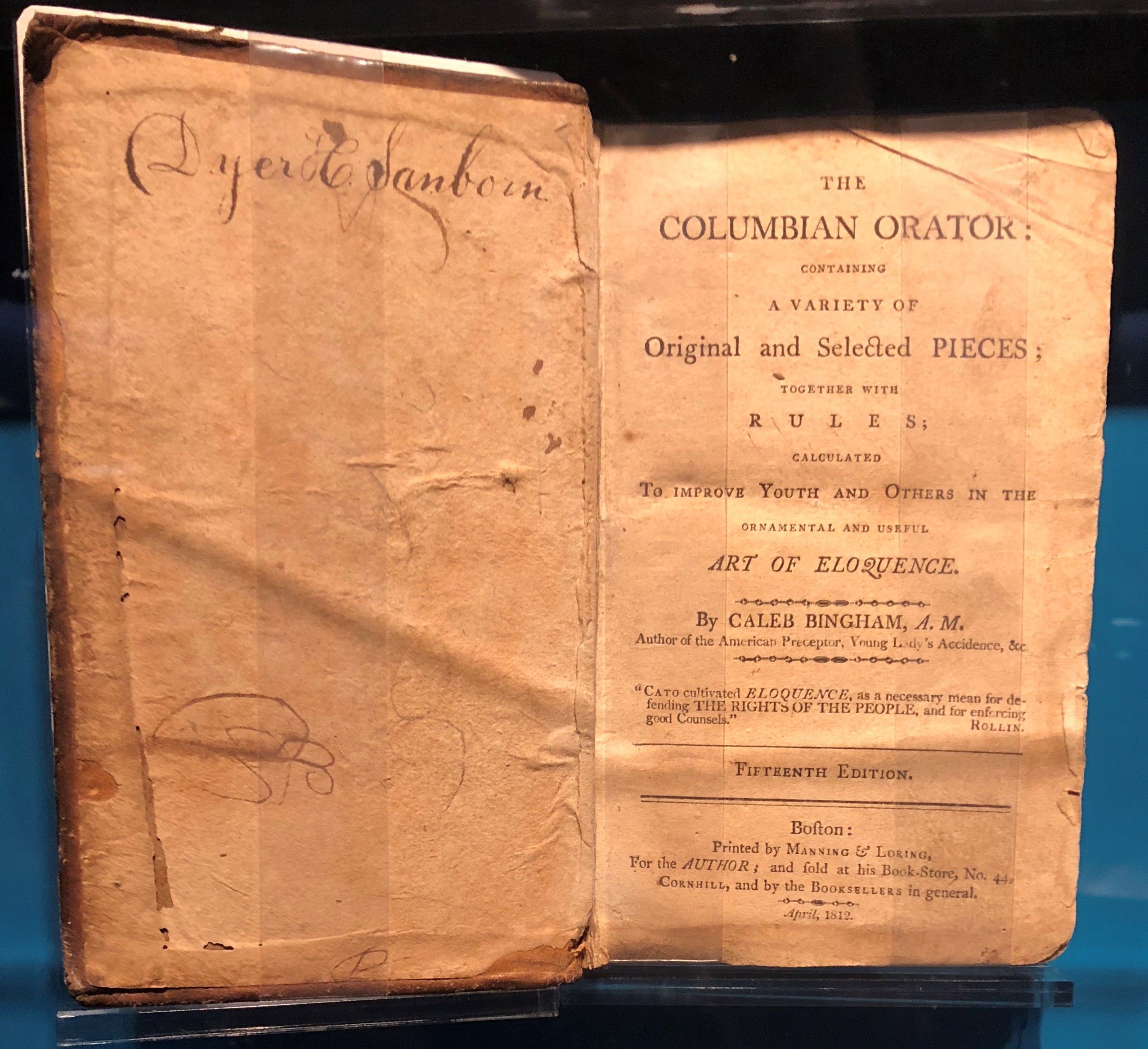Caleb Bingham on:
[Wikipedia]
[Google]
[Amazon]
 Caleb Bingham (1757–1817) was an educator and textbook author of late 18th-century
Caleb Bingham (1757–1817) was an educator and textbook author of late 18th-century
“Memoir of Caleb Bingham, with Notices of the Public Schools of Boston, prior to 1800.”
In Henry Barnard, ed., ''Memoirs of Teachers, Educators, and Promoters and Benefactors of Education, Literature, and Science''; Part 1: Teachers and Educators; Vol. 1: United States (New York: F. C. Brownell, 1859), pp. 53–77.
- "E Pluribus Unum Project," Assumption College
* {{DEFAULTSORT:Bingham, Caleb 1757 births 1817 deaths American instructional writers
 Caleb Bingham (1757–1817) was an educator and textbook author of late 18th-century
Caleb Bingham (1757–1817) was an educator and textbook author of late 18th-century New England
New England is a region comprising six states in the Northeastern United States: Connecticut, Maine, Massachusetts, New Hampshire, Rhode Island, and Vermont. It is bordered by the state of New York to the west and by the Canadian province ...
, whose works were also influential into the 19th and 20th. Among his most influential works were books on oratory
Oratory is a type of public speaking.
Oratory may also refer to:
* Eloquence, fluent, forcible, elegant, or persuasive speaking
* Rhetoric, the art of discourse
Places
* Oratory (worship), a public or private place of divine worship, akin to a ...
, or public speaking. A native of Salisbury, Connecticut
Salisbury () is a town situated in Litchfield County, Connecticut, United States. The town is the northwesternmost in the state of Connecticut; the Massachusetts-New York-Connecticut tri-state marker is located at the northwest corner of the tow ...
, he spent much of his career in Boston, Massachusetts as a publisher and bookseller. Bingham was educated at Dartmouth College
Dartmouth College (; ) is a private research university in Hanover, New Hampshire. Established in 1769 by Eleazar Wheelock, it is one of the nine colonial colleges chartered before the American Revolution. Although founded to educate Native ...
and valedictorian
Valedictorian is an academic title for the highest-performing student of a graduating class of an academic institution.
The valedictorian is commonly determined by a numerical formula, generally an academic institution's grade point average (GPA) ...
of his class of 1782. He also taught at the college.
One of his most popular works was ''The Columbian Orator
''The Columbian Orator'' is a collection of political essays, poems, and dialogues collected and written by Caleb Bingham. Published in 1797, it includes speeches by George Washington, Benjamin Franklin, and some imagined speeches by historical ...
'', originally published in 1797, an anthology which contained rules on oratory, but consisted primarily of texts for reading and recitation. The selections (from about three dozen writers) include poems, essays, short dialogues, and extracts from famous speeches. The content reflects a substantial concern with the moral education of youth and the preparation of citizens in the young Republic. (Selections include arguments made in Parliament in support of the American Colonies.) The book has continued in print into the late 20th century.
''The Columbian Orator'' served as an inspiration to many orators, including the African-American abolitionist
Abolitionism, or the abolitionist movement, is the movement to end slavery. In Western Europe and the Americas, abolitionism was a historic movement that sought to end the Atlantic slave trade and liberate the enslaved people.
The British ...
Frederick Douglass
Frederick Douglass (born Frederick Augustus Washington Bailey, February 1817 or 1818 – February 20, 1895) was an American social reformer, abolitionist, orator, writer, and statesman. After escaping from slavery in Maryland, he becam ...
, who purchased a copy as a young man and used it to develop his powerful public speaking style.
Two other well-known textbooks of Bingham's, also on reading, grammar, and oratory, were ''The American Preceptor'' (1794) and ''The Young Lady's Accidence'' (1785). ''The American Preceptor'' is similar to ''The Columbian Orator'' in its content. Selections (often about two pages in length) draw attention to the evils of slavery, the importance of clemency toward the unfortunate (including one's captive enemies), personal virtue and industry, religious tolerance
Religious toleration may signify "no more than forbearance and the permission given by the adherents of a dominant religion for other religions to exist, even though the latter are looked on with disapproval as inferior, mistaken, or harmful". ...
, and the education of girls. Some stories recite the acts of a virtuous American Indian, African, Moor, Catholic, or other person—sometimes in contrast to a less virtuous white or Christian character. Bingham also takes aim at characters who care more about fashion, entertainments, or lapdogs than about honest labor, solid education, and duties within the household. The publication of ''The Young Lady's Accidence'' was part of his advocacy for opening education to girls. The success of Bingham's books can be attributed in part to the dramatic and narrative interest of many selections.
Additional biographical and historical material appears in David W. Blight (ed. and new intro.), Caleb Bingham, ''The Columbian Orator: Containing a Variety of Original and Selected Pieces together with Rules, Which are Calculated to Improve Youth and Others, in the Ornamental and Useful Art of Eloquence'' (Bicentennial Edition, New York: New York University Press, 1998). For a biographical essay by someone who knew Bingham, see William S. Fowle, “Memoir of Caleb Bingham, with Notices of the Public Schools of Boston, prior to 1800.” Fowle's essay is also rich in detail concerning educational materials and practices during Bingham's lifetime.
External links
* William S. Fowle“Memoir of Caleb Bingham, with Notices of the Public Schools of Boston, prior to 1800.”
In Henry Barnard, ed., ''Memoirs of Teachers, Educators, and Promoters and Benefactors of Education, Literature, and Science''; Part 1: Teachers and Educators; Vol. 1: United States (New York: F. C. Brownell, 1859), pp. 53–77.
- "E Pluribus Unum Project," Assumption College
* {{DEFAULTSORT:Bingham, Caleb 1757 births 1817 deaths American instructional writers